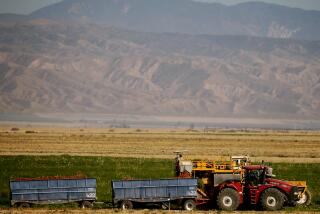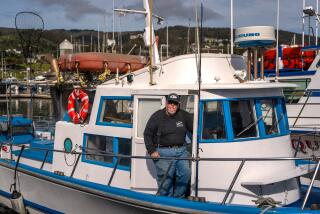Parched voices
Drought. Environmental regulations. Growing urban demand. It’s all meant less water for California farmers. Times editorial writer Marjorie Miller spoke with growers and a processor from the Central Valley about how water shortages have affected them. These are edited transcripts of their comments.
--
Bill Diedrich, Shields, Calif.
I have 515 acres of almonds, 75 acres of prunes and 23 acres of peaches, and I don’t have a choice: I have to irrigate. If I don’t irrigate, I’m going to lose all my capital investment. There have been some broad general statements about the water supply not being all that bad, only 5% off normal. Certainly for the Westside Central Valley Project, it’s not the truth. This growing year, we’re getting 90% less water than our usual allotment. That has to be made up through water purchases and transfers.
I’ve had to go to extraordinary lengths to obtain water to finish the production cycle this year. I’ve had to carry water from last year into this year. I’ve had to call on drought water that I banked in previous years. I’ve had to fallow 200 acres in another district to move that water to my permanent crops.
Our contract price is $100 an acre-foot. But for supplemental water, we’ll probably pay close to $400 an acre-foot this year. It’s a short-term way to keep our permanent crops alive in the hopes that there are better days ahead.
A long-term fix for the state -- certainly that’s years off, but we’re hoping that some of the more onerous pumping restrictions in the Sacramento-San Joaquin River Delta can be modified so we can get more water into the system. That’s the bottom line. We’re looking at a very small profit, if any at all, this year.
--
Todd Allen, Firebaugh, Calif.
The shortages started last year, and I barely had enough water to finish my crops, which consisted of wheat and cantaloupes. This year, I planted 375 acres of wheat in the first part of December. I intended to plant pima cotton on the rest of my 600 acres, but then they announced that our water allocation in January, February and March was zero. In April, I did receive a 10% allocation, but by then all but 40 acres of the wheat had dried up. It was too late, and I didn’t have enough water to plant anything else.
Now I’m going through my reserves to finish out the year. In the last five years, I was doing well enough to secure financing for equipment and a state-of-the-art drip irrigation system that uses less water, requires less fertilizer and produces higher yields. It is better for the environment because there is virtually no runoff. I really need to get my crop financing in order by November or I could be in serious financial trouble. I have payments on the equipment purchases due early next year.
I’ve had to lay off five employees due to this “regulatory drought.” Most of my employees have worked here for 15 to 20 years, and they have mortgages and car payments, just as I do. My suppliers are suffering as well. It’s all happening due to pumping restrictions to save a non-native species of fish, the three-inch delta smelt.
A ruling by a judge two years ago on an Endangered Species Act case has meant we lost 40% of our water supply. It was done to protect fish from the massive pumps that deliver water to farmland and cities. To my mind, the environmental groups who sued for this ruling don’t really care about the fish; they just want to turn this fertile land back into a desert and put farmers like me out of business. I wish they’d be honest about their intentions.
--
Brad Craven, Cantua Creek, Calif.
I am the general manager for an almond-hulling operation. We hull and shell almond meats. We are 100% dependent on farmers having water to deliver a crop to us. This year, we will be offering 20% fewer man-hours to the labor pool than we would have otherwise due to water-related yield reductions. If you consider all the post-harvest processing industries like cotton gins, almond hullers, dehydrators and cooling sheds, the losses are enormous.
I’m not a pessimist, but I really think agriculture may lose this one. We’re up against “Big Environment.” Environment has all the political support from the Democratic majorities in both the state and federal legislatures right now, and there’s really no need for them to compromise. On the other hand, agriculture recognizes that the environment needs a portion of the available water and that municipalities need a portion of the water. Agriculture has consistently compromised to the point where our effective water rights have been reduced to zero. There’s no need for the controlling political parties or the environmental groups to change their views. I think we just may lose, and then losses will spread far beyond the San Joaquin Valley.
More to Read
Sign up for Essential California
The most important California stories and recommendations in your inbox every morning.
You may occasionally receive promotional content from the Los Angeles Times.










